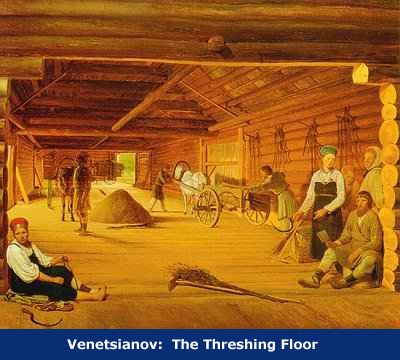

 Aleksei Gavrilovich Venetsianov is one of the most important Russian painters of the nineteenth century, best noted for his natural yet dignified portrayal of peasants, peasant life, and nature. He is credited with establishing genre painting (particularly related to peasant life) and developing the features of the national Russian landscape. Venetsianov is also recognized for the tremendous role he played in the education of the young artists of limited means.
Aleksei Gavrilovich Venetsianov is one of the most important Russian painters of the nineteenth century, best noted for his natural yet dignified portrayal of peasants, peasant life, and nature. He is credited with establishing genre painting (particularly related to peasant life) and developing the features of the national Russian landscape. Venetsianov is also recognized for the tremendous role he played in the education of the young artists of limited means.
Venetsianov was born in Moscow in 1780 in the family of a impoverished Greek merchant. He attended a private boarding school and was initially trained for government service as a woodland's surveyor. He studied painting in his free time and worked as a civil servant. Art studies exposed Venetsianov to natural colors and airy atmosphere permeating the paintings of French artist Francois-Marius Granet; the young Russian painter was so impressed that he decided to employ the same techniques in his paintings. In 1802, he moved to St. Petersburg and took courses as an external student at the Academy of Arts, at the same time spending long hours at the Hermitage copying the works of great masters, especially the Dutch landscape painters. In the Hermitage, Venetsianov met V. L. Borovikovsky and became his student. In 1810, the artist received from the Academy the title of a distinguished Associate, which contributed to the growth of his popularity. Two years later, during the Napoleonic campaign, he published a series of patriotic satirical etchings aimed at Napoleon and his allies. His love of nature and the countryside and his desire to paint it in a natural way, reminiscent of Granet, prompted Venetsianov to buy a small estate in the Tver province. He retired in 1820 and summarily abandoned forever his satirical and political art. Moving permanently to his home in the countryside, he focused most of his energy on the depiction of peasants and village life. Moreover, in 1824, after selling The Threshing Barn for a large sum of 5,000 roubles, Venetsianov decided to share his good fortune and established in his house an art school for talented students who could not afford art education. Over the course of its existence, the school enrolled about 70 pupils. Among those who distinguished themselves later were G. Soroka, N. Krylov, A. Alexeev, L. Plakhov, A. Tyranov, K. Zelentsov, S. Zarianko, and G. Mikhailov. Their knowledge of the subject and their ability to portray it in a straightforward and unaffected way helped to develop farther the genre of peasant painting.
Alexsei Venetsianov's best known works include In The Field: Spring (mid 1820s), The Threshing Floor (1821 or 1822), Sleeping Shepherd (between 1823 and 1826), The Morning of a Landlady (1823), Reaper (1820s), Reapers (1820s), and Harvesting: Summer (mid 1820s). The characteristics of his works that made a memorable and lasting impression on the Russian art scene were his disregard for the common rules and techniques used by most artists during the nineteenth century. Crossing the line dividing art and reality, Venetsianov created beautiful and somewhat idealistic representations of peasants and depicted the virtues of peasant life while using natural light and natural environment to show a realistic image of everyday life. Since Venetsianov loved nature and the outdoors, most of his paintings were created "en plein air;" this method of work gave all his paintings a certain spontaneity, freshness, and luminosity. Living and working among peasants, the artist understood their life and developed the proper perspective to paint them. His paintings were often a combination between true portraits and general types; using the works of old masters as examples, Venetsianov seemed to follow Renaissance ideas about composition and presentation of the figures (The Russian Museum, 61).
Venetsianov's major contributions to the world of nineteenth century art included:
recognition and acknowledgement of the importance of light in painting,
blending of the figures with the landscape to create unity between humans and nature,
showing the virtues rather than the vices of peasants,
painting aristocratic subjects in informal and casual surroundings, and
making a transition to the techniques of early Romanticism (Bird, 105-108) [F.S.].
[Sources: Bird, The Russian Museum, Klimov.]
